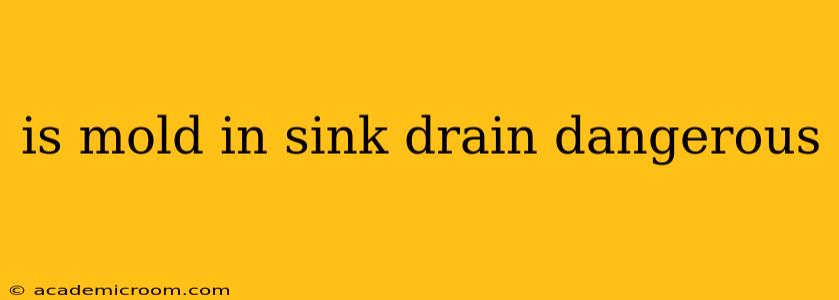Mold in your sink drain might seem like a minor inconvenience, but it's crucial to understand the potential health risks and how to address this issue effectively. Ignoring mold growth can lead to various health problems and even damage your plumbing system. This comprehensive guide will explore the dangers of sink drain mold, its causes, and how to safely remove and prevent it.
What are the dangers of mold in a sink drain?
Mold in your sink drain isn't just unsightly; it can pose significant health risks. The spores released by mold can trigger allergic reactions in sensitive individuals, leading to symptoms like sneezing, coughing, itchy eyes, and skin rashes. For those with asthma, mold exposure can worsen respiratory symptoms. In severe cases, prolonged exposure to certain types of mold can lead to more serious health issues. The exact dangers depend on the type of mold present and the level of exposure.
What causes mold growth in sink drains?
Mold thrives in damp, dark environments, making sink drains a perfect breeding ground. The constant presence of moisture from water dripping down the drain, combined with organic matter like food particles and hair, provides the ideal conditions for mold spores to germinate and grow. Poor ventilation in the bathroom or kitchen also contributes to the problem. Essentially, stagnant water and organic debris are the main culprits.
Can mold in a sink drain make you sick?
Yes, mold in a sink drain can make you sick, although the severity of the illness varies depending on several factors. These include:
- Type of mold: Some molds are more allergenic or toxigenic than others.
- Amount of mold: A small amount of mold might cause minor irritation, while extensive growth can lead to more serious health problems.
- Individual sensitivity: People with pre-existing respiratory conditions or allergies are more susceptible to mold-related illnesses.
- Length of exposure: Prolonged exposure to mold significantly increases the risk of developing health issues.
Symptoms can range from mild allergic reactions to more severe respiratory problems. If you suspect mold-related illness, consult a doctor immediately.
How do I know if I have mold in my sink drain?
Mold in a sink drain isn't always easily visible. However, there are several signs that might indicate its presence:
- Musty odor: A persistent, unpleasant smell emanating from your drain is a strong indicator of mold growth.
- Visible mold: Check for slimy, discolored growth around the drain opening. Mold can be various colors, including black, green, white, or gray.
- Slow draining: Mold and other organic matter can clog your drain, leading to slow drainage.
- Recurring drain clogs: Frequent clogs might indicate a build-up of mold and debris in your pipes.
How do I get rid of mold in my sink drain?
Removing mold from your sink drain requires a multi-pronged approach:
- Cleaning: Use a mixture of baking soda and vinegar to clean the visible mold around the drain opening. Let it fizz for a few minutes, then scrub with a brush and rinse thoroughly.
- Boiling Water: Pouring boiling water down the drain can help kill mold spores and dislodge organic debris. Be cautious when handling boiling water.
- Commercial Drain Cleaners: Use a commercial drain cleaner specifically formulated to kill mold and remove organic matter. Always follow the manufacturer's instructions carefully and ensure adequate ventilation. Note: Consider the environmental impact of harsh chemical cleaners.
- Prevention: Regularly clean your drains to prevent future mold growth. Avoid pouring grease or oil down the drain. Ensure good ventilation in your bathroom or kitchen.
Remember, if the mold infestation is severe or you're uncomfortable dealing with it yourself, it's best to consult a professional plumber.
Is mold in the drain pipe dangerous?
Yes, even mold growing within the drain pipe itself can be dangerous. While you may not see it directly, the spores can still be released into the air, potentially causing health problems. Addressing the underlying causes of moisture and organic matter build-up in the pipes is crucial for long-term prevention.
How do I prevent mold in my sink drain?
Prevention is key to avoiding mold in your sink drain. Here are some effective strategies:
- Regular Cleaning: Clean your drains regularly with baking soda and vinegar or a drain cleaner.
- Proper Ventilation: Ensure adequate ventilation in your bathroom and kitchen to reduce humidity.
- Avoid Grease and Oil: Never pour grease or oil down the drain.
- Use a Drain Strainer: Use a drain strainer to catch hair and food particles before they reach the drain.
- Periodic Flushing: Occasionally flush your drains with boiling water to dislodge any debris.
By following these simple steps, you can significantly reduce the risk of mold growth in your sink drain and maintain a healthy home environment. Remember, early detection and prompt action are vital in dealing with sink drain mold effectively and safely.
